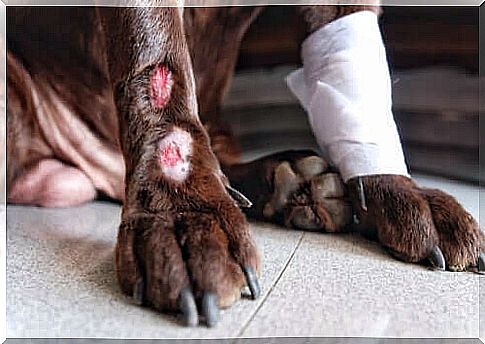Interesting Facts About Tetanus In Dogs

You may have wondered if tetanus can also occur in dogs and why they are not vaccinated. The answer is that while dogs can get tetanus, they are relatively resistant to it.
Therefore , this disease is rare in dogs. In contrast, humans and horses are very susceptible to tetanus, while cats are also very resistant.
Causes of Tetanus in Dogs
The disease is caused by an infection with the bacterium Clostridium tetani, which enters the body through wounds. It is important to know that C. tetani is naturally present in some soils. This bacteria is not only present in oxidized metal, but also in the dirt of that metal. Keep this information in mind and be careful if you injure yourself with sharp objects, whether they are rusty or not.
It is also worth knowing that the disease is not caused by the bacteria itself, but is triggered by a neurotoxin called tetanospasmin.
The bacteria enter the body through a wound and then inoculation begins. After a few days, the spores of the bacteria form an oxygen-poor environment and begin to produce the poison. This connects to the tissues in the nervous system and causes the classic symptoms of tetanus.
It is also interesting that the bacteria that come into contact with the animal’s skin or are ingested orally are not a problem. This bacteria needs low-oxygen conditions to produce the toxin.

Symptoms of Tetanus
Symptoms of tetanus usually appear 5-10 days after the initial injury. However, in some cases, symptoms may appear earlier or up to three weeks after exposure.
The poison acts on the nerves, the spinal cord and the brain, which leads to hyperexcitability and muscle spasms as a result. There are two types of tetanus that can occur in dogs:
1. Localized tetanus
It is the most common type of tetanus in pets. Affected dogs develop muscle stiffness in the leg or muscles closest to the wound.
In addition to muscle stiffness , muscle tremors can also occur. Localized tetanus can progress to generalized tetanus over time, but it doesn’t have to be.
2. Generalized tetanus
In this case, large areas of the body are affected. Affected animals walk very stiffly, with their tails raised or stretched backwards.
These animals can get so stiff that they cannot bend their legs to stand up. Many develop a so-called “sawhorse posture” in which all four legs are in a rigid position.
In generalized tetanus, the facial muscles are often affected. Many animals develop raised eyelids and a wrinkled forehead due to muscle spasms. In addition, the lips freeze in an expression called Risus sardonicus, which means something like “devilish smile”.
The jaws are often rigidly closed, which often serves as a distinguishing feature. Affected dogs may not be able to swallow, causing difficulty eating and excessive salivation.
In some cases, tetanus can cause muscle spasms in the throat or diaphragm (the muscle that regulates breathing), making it difficult for the dog to breathe.

Many patients with generalized tetanus also develop a fever. This fever is usually not due to a bacterial infection, but is caused by the heat created by the constant contraction of muscles.
Treatment of tetanus in dogs
Treatment for tetanus consists primarily of general supportive care. This treatment is maintained while the dog’s nervous system recovers from damage from the effects of the neurotoxin.
Dogs with generalized tetanus cannot walk. For this reason, they need very intensive care. This care includes the use of soft bedding and constant changes in the animal’s posture to avoid ulcers (“bed sores”).
In addition, in some cases it is necessary to feed the dog with a nasogastric or gastric tube.
You also have to help him empty his bladder so as not to expose him to unpleasant stimuli. Keeping the dog in a quiet, dark environment will help reduce the discomfort caused by tetanus attacks.
Recovery can take weeks or even months. But if the animal is well cared for and cared for, it has the best chance of survival.

There is no vaccination against tetanus in dogs
If you notice that your dog has barbed wire wounds, it should be alerted immediately. You’re probably wondering: what now? Shouldn’t he be vaccinated against tetanus?
Unfortunately, no vaccine can be given in this case. There are several FDA-cleared tetanus toxoid vaccines for humans, horses, and sheep, but there is no vaccine for tetanus in dogs .
Because tetanus is relatively rare in dogs, selling a tetanus toxoid vaccine for dogs is unlikely to ever make up for a drug manufacturer’s development costs. So it’s no wonder it hasn’t been developed yet.
In addition to the economic side, there are also moral aspects to vaccine development. To see if a vaccine against tetanus works in dogs, researchers first need to infect the dogs with tetanus and then treat them.
The resulting infection and disease, the treatment and the possible side effects of the vaccines would lead to significant suffering and death in laboratory animals. It is therefore unlikely that this vaccine will be developed.
What preventive measures can be taken?
The first thing to do is to carefully and carefully clean all wounds. Bites and stab wounds are at particular risk for developing tetanus. If your dog suffers such injuries, see your veterinarian.
You can also watch your dog’s behavior closely if he has an open wound. If you notice stiffness at the site of the injury, stop waiting and see a veterinarian immediately. The earlier tetanus is recognized and treated, the better the prognosis!









